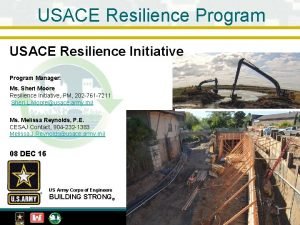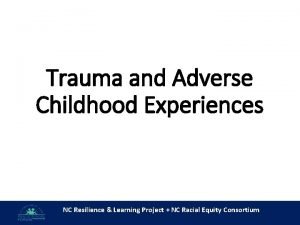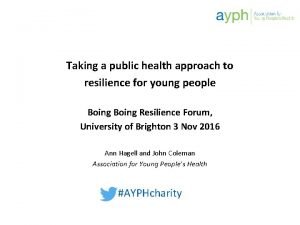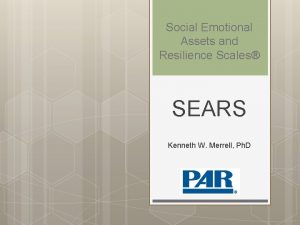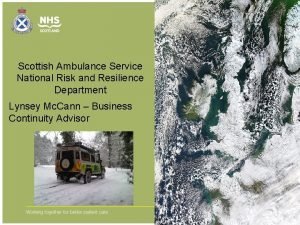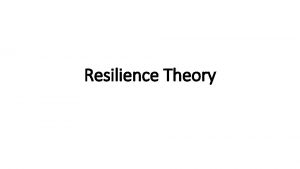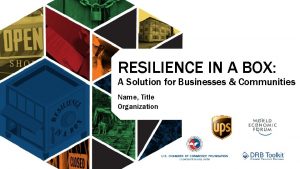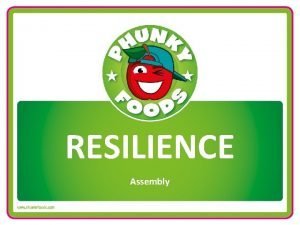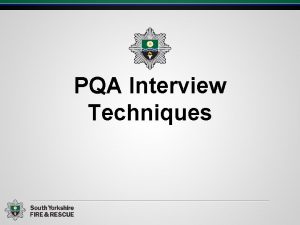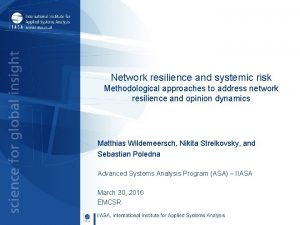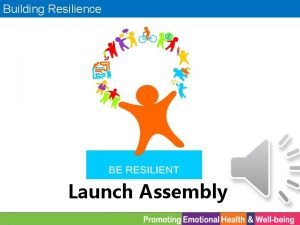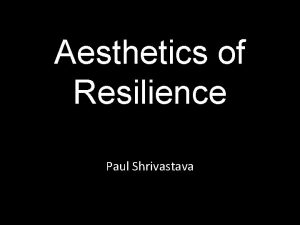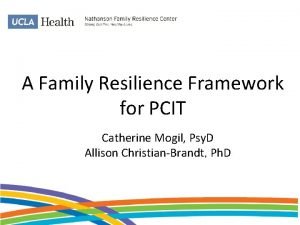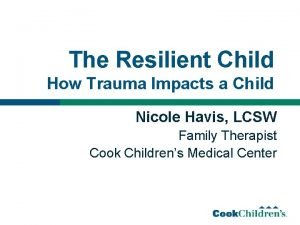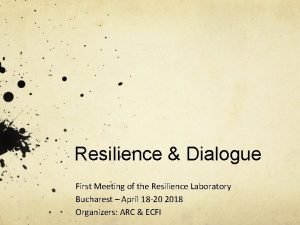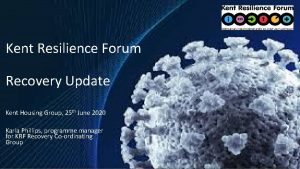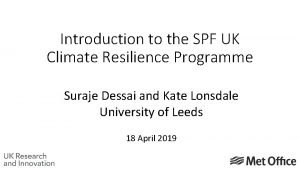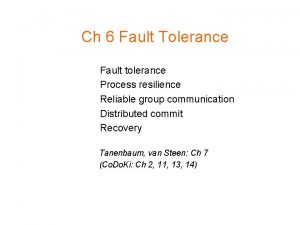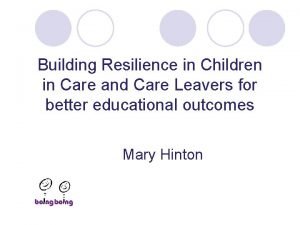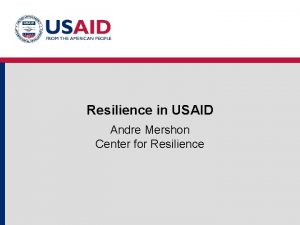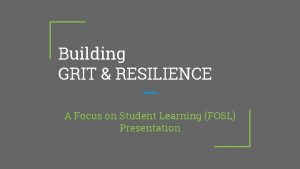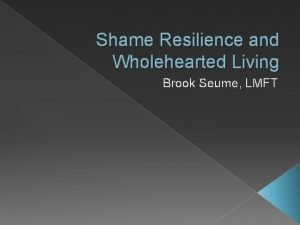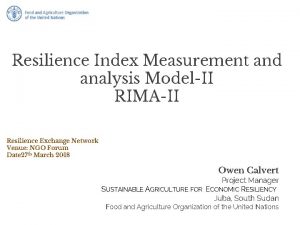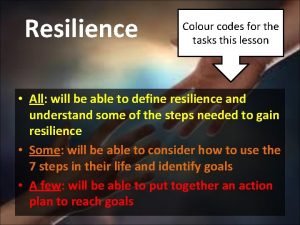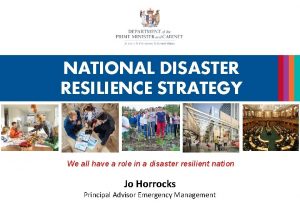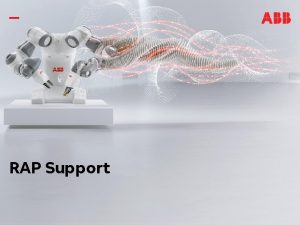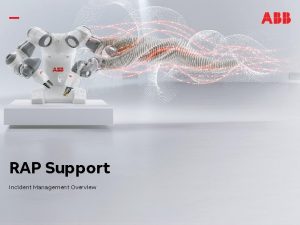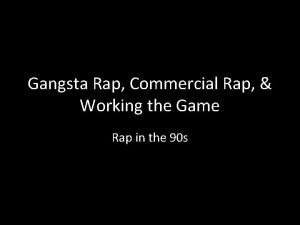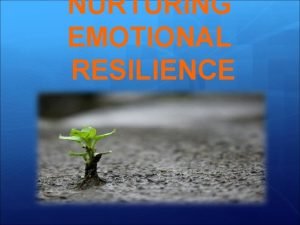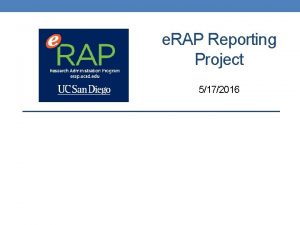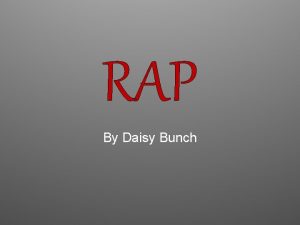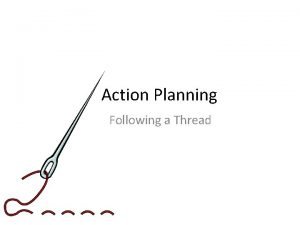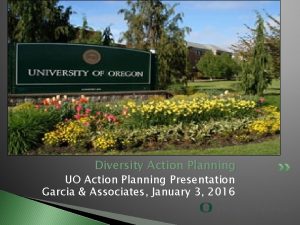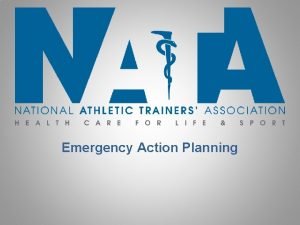CITY RESILIENCE ACTION PLANNING City RAP Tool City




































- Slides: 36

CITY RESILIENCE ACTION PLANNING (City. RAP) Tool

City. RAP: A flagship Di. MSUR initiative Di. MSUR mandate: Provide technical assistance and knowledge on Disaster Risk Reduction, Climate Change Adaptation and Urban Resilience in response to the needs of Member States. DIMSUR Launch Event, Maputo, June 2013 • Initially concerning Mozambique, Madagascar, Comoros and Malawi • Non-Profit • Autonomous/non political • Regional/international status • Headquartered in Maputo with representation in each Member State • Open membership to other sub-Saharan African countries

KEY CHALLENGES FOR BUILDING RESILIENCE in small and medium cities, or at the neighbourhood level of bigger cities 1. Lack of technical capacity and experiences 2. Lack of data and information 3. Lack of financial resources Existing tools are often too complex, data hungry and not adapted to the reality of these cities

THE CITY RESILIENCE ACTION PLANNING TOOL Four principles: 1 3 Targets small to intermediate cities or municipal districts within bigger cities Leverages local knowledge through clear concepts and a participatory approach 2 4 The municipality is the leader of the process from day one Leads to a Resilience Framework for Action


The 5 Resilience Pillars of the City. RAP Tool Urban Disaster Risk Management Urban Governance Urban Economy and Society Urban Planning and Environment Resilient Infrastructure and Basic Services

CITYRAP Tool Process PARTICIPATORY DATA COLLECTION AND ORGANISATION 8 -9 WEEKS Risk Mapping, Community Consultations Self assessment DATA ANALYSIS AND PRIORITISATION Focus Group Discussions Prioritisation Workshop PARTICIPATORY ELABORATION OF THE RESILIENCE FRAMEWORK FOR ACTION Technical Workshops 200 -300 people directly participate • Local government • Public institutions • Community representatives • CSOs and NGOs • Media • Private sector • Academia

Four Phases WEEK 1 WEEK 2 PHASE 1 Crash Course 4 -day workshop for building the understandin gof key concepts of risk and resilience and the tool methodology Delivered on -site by team of experts WEEK 3 WEEK 4 PHASE 2 Data Collection and Organisation Municipal Self Assessment Participatory Planning at neighbourhood level Data compilation and Organisation WEEK 5 PHASE 3 WEEK 6 WEEK 7 PHASE 4 WEEK 8 Data Analysis & Prioritisation Preparation, Review and Validation of the Resilience Framework of Action (RFA) Focus group discussions and Prioritisation of issues needing specific attention to build resilience Finalising and Validating the RFA with city officials and different stake-holders Drafting and Reviewing the RFA by the municipality involving various stakeholders Municipal focal points lead the process Team of experts provide on site support

PREPARATORY PHASE – Phase 0 Preliminary questionnaire to the city Designation of Municipal Focal Points by the Mayor Stakeholders mapping

CRASH COURSE: Promoting the understanding Phase 1

Use of a language easy to understand, although scientifically rigourous

Phase 1 GROUP EXERCISES Games and collective discussions on issues and ideas related to urban resilience and

RISK MAPPING AT CITY LEVEL Identify the main risks that affect the city Choose neighborhoods for community risk mapping Phase 1

TRAINING THE MUNICIPAL FOCAL POINTS Provide Municipal Focal Points with knowledge and skills to lead the resilience planning process Phase 1

DATA COLLECTION AND ORGANISATION: INSTITUTIONAL SELF ASSESSMENT § Assess the state of the city’s resilience through the knowledge, opinions and perceptions of municipal staff § Raise awareness on urban resilience Phase 2

MUNICIPAL SELF- ASSESSMENT 5 sections (one per resilience pillar) Phase 2

Phase 2 A MATRIX OF RESULTS EASY TO

Phase 2 MAPPING USING SATELLITE IMAGES: THE KEY LINK TO ENSURE PARTICIPATION OF THE COMMUNITIES

Phase 2 PRIORITY ISSUES AT COMMUNITY LEVEL

FOCUS GROUP DISCUSSIONS FOR EACH RESILIENCE PILLAR Thematic focus groups (representatives from municipality, community, NGOs, CSOs and other relevant stakeholders) for each pillar of resilience analyse the data collected during Phase 2 and discuss the main shortcomings and priorities. Phase 3

PRIORITISATION WORKSHOP Phase Key local stakeholders convene to discuss and decide upon priorities to build urban resilience based on the results of municipal self-assessment, community consultations and focus group discussions. 3

The funnelling process to prioritise and plan Urban Governance Urban Planning and Environment Resilient Infrastructure and Basic Services Urban Econom y and Society PRIORITISATION 1. Climate Change Adaptation & Mitigation 2. Sustainable Urban Growth 3. Inclusive and safer cities City Resilience Framework for Action (RFA) Urban Disaster Risk Management Phase 3 Phase 4

Filtering through the Resilience Diagramme

From the IDENTIFIED PROBLEMS to the PLANNED ACTIONS Phase 4

EVALUATION DE BASE Gestion des déchets solides Eau, assainissement et drainage Economie/ création d’emploi Aménagement urbain/ espaces publics Energie Politiques et législation Plans 1 2 3 3 1 1 3 1 2 2 2 1 1 1 2 2 1 2 3 2 2 Organisation Finance institutionnelle Interventions

ACTIONS PRIORITAIRES (5) Politiques et législation Plans Organisation institutionnelle Finance Interventions Gestion des déchets solides 1 1 2 2 2 Eau, assainissement et drainage Economie/ création d’emploi Aménagement urbain/ espaces publics 2 1 2 3 3 2 1 1 3 1 1 1 2 Energie 3 2 2 Action prioritaire 1: Mis en oeuvre d’une stratégie au niveau du Grand Moroni (inter-communale) pour gérer le problème des déchets et incluant un système de financement efficace

Politiques et législation Plans Organisation institutionnelle Finance Interventions Gestion des déchets solides 1 1 2 2 2 Eau, assainissement et drainage Economie/ création d’emploi Aménagement urbain/ espaces publics 2 1 2 3 3 2 1 1 3 1 1 1 2 Energie 3 2 2 Action prioritaire 2: Elaborer et mette en œuvre un Schéma d’Aménagement du Territoire (SAT) et Plans Locaux d’Urbanisme (PLU) en portant une attention particulière aux questions de l’accès à l’eau, à l’électricité , assainissement et système de drainage ainsi que des pôles économiques de développement

Politiques et législation Plans Organisation institutionnelle Finance Interventions Gestion des déchets solides 1 1 2 2 2 Eau, assainissement et drainage Economie/ création d’emploi Aménagement urbain/ espaces publics 2 1 2 3 3 2 1 1 3 1 1 1 2 Energie 3 2 2 Action prioritaire 3: Définir et mettre en œuvre un système de financement durable en matière d’aménagement urbain (eau, assainissement, drainage, route et énergie)

Politiques et législation Plans Organisation institutionnelle Finance Interventions Gestion des déchets solides 1 1 2 2 2 Eau, assainissement et drainage Economie/ création d’emploi Aménagement urbain/ espaces publics 2 1 2 3 3 2 1 1 3 1 1 1 2 Energie 3 2 2 Action prioritaire 4: Renforcer le cadre institutionnel pour la gestion de l’aire urbaine du « Grand Moroni »

Politiques et législation Plans Organisation institutionnelle Finance Interventions Gestion des déchets solides 1 1 2 2 2 Eau, assainissement et drainage Economie/ création d’emploi Aménagement urbain/ espaces publics 2 1 2 3 3 2 1 1 3 1 1 1 2 Energie 3 2 2 Action prioritaire 5: Promouvoir l’écotourisme et l’économie tertiaire en se focalisant sur l’intégration des jeunes actifs

From PLANNED ACTIONS to the preparation for the actual IMPLEMENTATION Phase 4 • The identified priority actions are discussed in specialised focus groups and are broken down into activities with assigned responsibilities • Activities are categorised temporally into shortterm (0 -2 years), medium-term (3 -5 years) and long-term (6 -10 years) • A required budget is estimated for each activity • ONE responsible office/entity is assigned to EACH activity (NB: if an activity involves more offices/entities, then a LEAD ENTITY will be assigned for coordination purposes)

MAPPING COMPONENT Phase 4

Set up a MONITORING and EVALUATION Framework Phase 4 • A spider web per RFA Component is prepared, starting with the baseline assessment in terms of scoring for each priority issue • The evolution/performance of each RFA Component is monitored every two years and short evaluation report is produced • The RFA is updated based on the recommendations derived from the 2 -years evaluation report

Comment évaluer les progrès des problèmes prioritaires ? Plans Gestion des déchets solides 3 Politiques et législation 2 1 Interventions Organisation institutionnelle Finance

Comment évaluer les progrès des composantes? Gestion des déchets solides 3 Eau, assainissement et drainage Politiques et législation 2 Economie/ création d’emploi 1 Energie Aménagement urbain/ espaces publics

CITY RAP RESPONDING TO CHALLENGES in small and medium cities, or at the neighbourhood level of bigger cities 1. Lack of technical capacity and experience Reinforces capacity, transfer skills and tools to municipal technicians through trainings, on-the-job exercises and group activities 2. Lack of data and information Leverage local knowledge and information to kickstart processes; identify key gaps for future action through the RFA 3. Lack of financial resources RFA can be powerful tool mobilising and channeling resources
 Rap rap artinya
Rap rap artinya Potter's tool is data cleaning tool
Potter's tool is data cleaning tool Types of resilience
Types of resilience Nc resilience and learning project
Nc resilience and learning project Boing boing resilience
Boing boing resilience Sears rating scale
Sears rating scale National risk and resilience unit scotland
National risk and resilience unit scotland Meaning of resilience
Meaning of resilience Business resilience 101 workbook
Business resilience 101 workbook Resilience assembly
Resilience assembly Pqa example answers
Pqa example answers Network resilience a systematic approach
Network resilience a systematic approach Resilience in dental materials
Resilience in dental materials Modulus of toughness
Modulus of toughness Assembly on resilience
Assembly on resilience Resilience aesthetic
Resilience aesthetic Nathanson family resilience center
Nathanson family resilience center I have resilience
I have resilience Emotional resilience in nursing
Emotional resilience in nursing Army mrt modules
Army mrt modules I have resilience
I have resilience Kent resilience forum
Kent resilience forum Uk climate resilience programme
Uk climate resilience programme Emotional resilience in social work
Emotional resilience in social work Resilience vs fault tolerance
Resilience vs fault tolerance Building resilience skipper
Building resilience skipper I have resilience
I have resilience Lbld meaning
Lbld meaning Usaid
Usaid Resilience pyramid
Resilience pyramid Building grit in students
Building grit in students 12 categories of shame
12 categories of shame Resilience index measurement and analysis
Resilience index measurement and analysis Resilience direct
Resilience direct Resilience colour
Resilience colour National resilience strategy
National resilience strategy Resilience practice
Resilience practice


